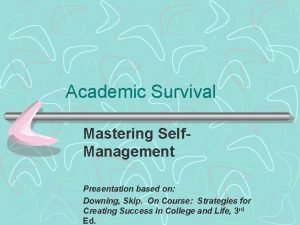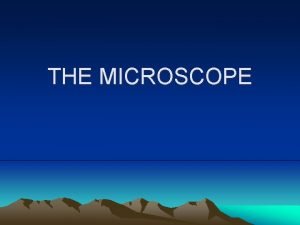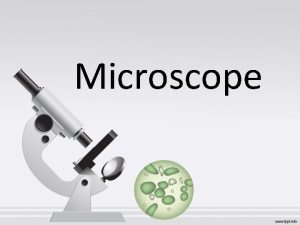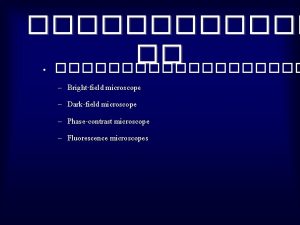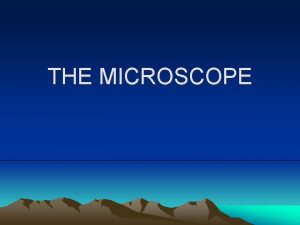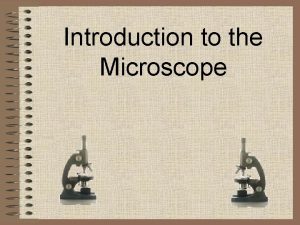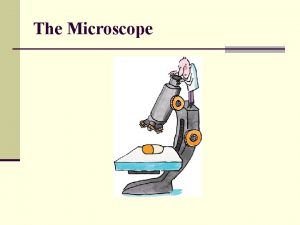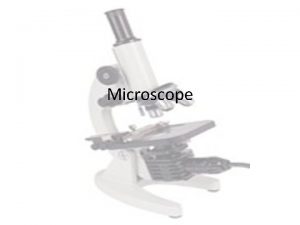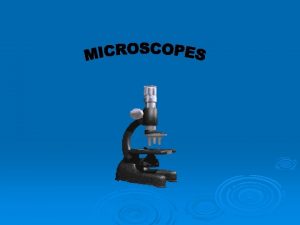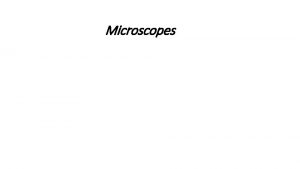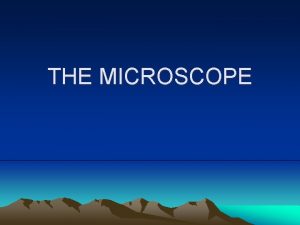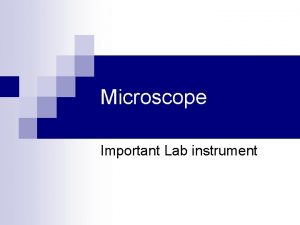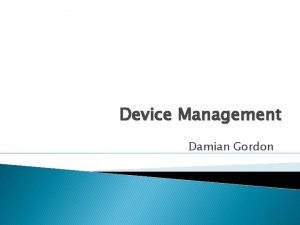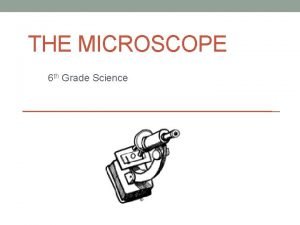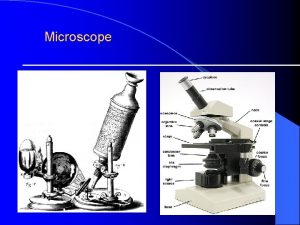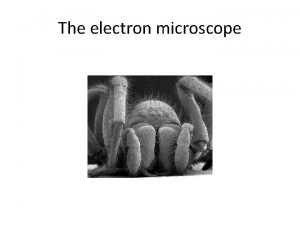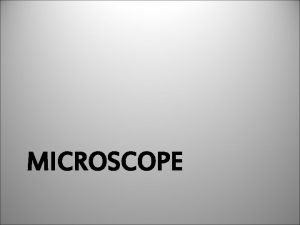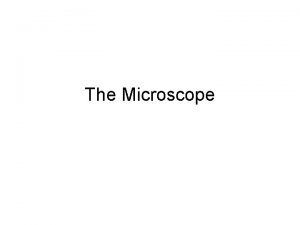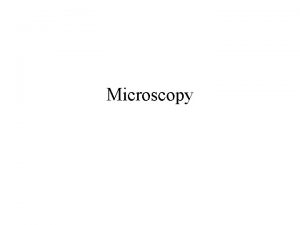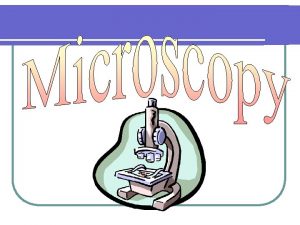Microscope O Microscope is an important device that




























- Slides: 28

Microscope

O Microscope is an important device that enables us to visualize minute objects (animate and inanimate) that cannot be seen by our naked eye.

Major parts of microscope A. Frame work of the microscope This includes: - An arm (stand): - The basic frame of the microscope to which the base, body and stage are attached. - A stage: - the table of the microscope where the slide or specimen is placed. - A foot, or base: - is the rectangular part up on which the whole instruments rest.

B. Focusing system This encompasses: O Coarse and fine focusing adjustments Course adjustment The course focusing adjustment is controlled by a pair of large knobs positioned one on each side of the body. Rotations of these knobs move the tube with its lenses, or in some microscope the stage, up or down fairly rapidly. Fine adjustment While low power objectives can be focused by the course adjustment, high power objectives require a fine adjustment.

O Condenser adjustments The condenser is focused usually by rotating a knob to one side of it. This moves the condenser up or down. The condenser aperture is adjusted by the iris diaphragm, which is found just below the condenser. The principal purpose of the condenser is to condense the light required for visualization

Magnification system This comprises: O Objectives are components that magnify the image of the specimen to form the primary image. For most routine laboratory work, 10 x, 40 x, and 100 x (oil immersion) objectives are adequate.

O Eyepiece is the upper optical component that further magnifies the primary image and brings the light rays to a focus at the eye point It is available in a range of magnifications usually of 4 x, 6 x, 7 x, 10 x, 15 x and sometimes as high as 20 x. N. B: Based on their number of eyepiece, microscopes can be classified as monocular and binocular microscopes.

C. Illumination system O Condenser and iris - Condenser is a large lens with an iris diaphragm. - The condenser lens receives a beam from the light source and passes it into the objective.

-The iris is a mechanical device mounted underneath the - Condenser and controls the amount of light entering the condenser. O Mirror - Mirror is situated below the condenser and iris. - It reflects the beam of light from the light source up wards through the iris into the condenser. The mirror is used to reflect ray or electrical light

Sources of illumination O Day Light Ordinary daylight may be sufficient for some work. Daylight, however, is scarcely enough for oil immersion work. O Electric light tungsten lamps. Many microscopes are now provided with correctly aligned built-in sources of illumination, which use tungsten or quartz halogen lamps operating on 6, 8 or 12 volts through variable transforms. O Filters Light filters are used in the microscope to: - Reduce the intensity of light; - Increase resolution; -Protect the eye from injury caused by ultra-violet light.

Working principle of the microscope O A microscope is a magnifying instrument. O The magnified image of the object (specimen) is first produced by a lens close to the object called the objective. O This collects light from the specimen and forms the primary image. O A second lens near the eye called the eyepiece (ocular) enlarges the primary image converting it into one that can enter the pupil of the eye.

O The magnification of the objective multiplied by that of the eyepiece, gives the total magnification of the image seen in the microscope. O See the following example: Objective Magnification Eyepiece Magnification Total Magnification 10 X 100 X 40 X 10 X 400 X 10 X 1000 X

The numerical aperture (NA): Is a designation of the amount of light entering the objective from the microscopic field NA = R sin µ Where R is the refractive index of glass µ is the angle made by one ray passing through edge and another through the center of the lens Then NA depends on the radius of the lens.

O Resolving power: Is the useful limit of magnification, it is the ability of microscope, at specific magnification to distinguish two separate objects situated close to one another and the ability of the lens to reveal fine details. O The smaller the distance between the two specific objects that can be distinguished apart, the greater the resolution power of the microscope. O Minimal distance between two objects = (0. 612 X ) / NA O The larger NA, the smaller the resolvable distance and hence, the more efficient the resolution power.

Working principle of an oil immersion O When a beam of light passes from air into glass it is bent and when it passes back from glass to air it is bent back again to its original direction. O This has effect on oil immersion objective and affects the NA of the objective and consequently its resolving power. O The bending effect on the objective can be avoided by replacing the air between the specimen and the lens with oil, which has the same optical properties as glass, i. e. immersion oil. By collecting extra oblique light, the oil provides better resolution and a brighter image

Light path through the high dry objective lens (A) & Oil immersion lens (B) A B

Routine use of the microscope A microscope must always be used with gentleness; care and the following should be noted. 1. Place the microscope on a firm bench so that it does not vibrate. • Make sure that it is not be exposed to direct sun light. • The user must be seated at the correct height for the convenient use of the microscope. 2. Select the appropriate source of light. 3. Place the specimen on the stage, making sure that the underside of the slide is completely dry.

4. Select the objective to be used. O It is better to begin examination with 10 x objective. O The 10 x objective can be used for adjusting the illumination and for searching the specimen before using a high power lens. 5. Bring the objective as close as possible to the slide preparation and while viewing in the eye piece slowly move the objective up ward with the coarse adjustment until the image comes into view and is sharply focused. 6. Adjust the light source until the illumination of image is at its brightest.

7. Focus the condenser. To do this, open fully the iris of the condenser. Using the condenser adjustment knob, focus the condenser on the details of the light source. 8. Adjust the aperture (opening) of the condenser iris according to the specimen being examined. O The wider the condenser aperture, the brighter will be the specimen and the smaller will be the details, which can be resolved. O The smaller the aperture, the greater will be the contrast

9. Examine the specimen by systematically moving the slide with the mechanical stage. N. B: The image of the specimen will be up side down and will move in the opposite direction to the side. 10. For a higher magnification, swing the 40 x objective into place. • Focus the 40 x objective, using the fine adjustment. • If for any reason the image is not visible, lower the objective until it is nearly but not quite touching the specimen. • Then looking through the eyepiece, focus up wards with the fine adjustment until the image comes into view.

O For the highest magnification, add a drop of immersion oil to the specimen and swing the 100 x oil immersion objective into place, then open the iris fully to fill the objective with light. Example, stained blood smear, acid-fast stain, etc.

Types of microscopy Ultraviolet Microscopy: The shorter wavelength of UV can extend the limit of microscope resolution to about 0. 1 m. However, UV light is invisible to the human eye, so the image must be recorded on a photographic plate or fluorescent screen. Because this light is absorbed by glass, all lenses must be made of quartz, such microscopes are two expensive for routine use

Fluorescence microscopy A sample labeled with a fluorescent dye is illuminated with UV light, the location of the dye in the specimen is revealed by its fluorescence or emission of visible light Dark field Microscopy One sees a black background, against which suspended bacteria or element appear bright. The dark field microscope uses a special condenser that illuminate the sample with a hallow cone of light in such a manner the light is not directed into the objective lens, revealing the shape of that object.

Phase contrast Microscopy Bacterial or animal cells are difficult to be seen using the light microscope unless the sample is dried and stained. This microscope enhances the slight difference in refractive index between the cells and the medium and thus can be used to visualize the living bacteria and platelets, in which the slight differences in RI are converted to differences in light intensity.

Electron Microscopy Since magnification greater than 1500 X to 2000 X are not practical with the light microscope due to decreased efficiency in resolving power. The electron microscope has come into use, where magnification of 50, 000 X may be obtained, with a high degree of resolving power. There are two types of electron microscope: 1. Transmission Electron Microscope (TEM) {2 dimensional} 2. Scanning Electron Microscope (SEM) {3 dimensional}

Care, cleaning, and repair of the microscope 1. Care and cleaning A microscope is a delicate instrument both mechanically and optically. Therefore, the following important points should be taken into considerations 1. Always carry a microscope using both hands. 2. When not in use, a microscope should be protected from dust, moisture, direct sunlight and put in microscope case.

3. Keep it standing in place ready for use, but protected by light cover. 4. In humid climate it is necessary to cover the microscope in a plastic bag with a drying agent (silica gel) over night to avoid molds growing on the lenses. 5. At the end of each day’s work, the surface lenses of the objectives, eyepieces, and condenser should be cleaned using lens tissue. N. B: Never clean the lens of the objectives and eyepiece with alcohol.

2. Repair of the microscope Except for obvious and simple measures, if a microscope becomes damaged optically or mechanically, it is better to send it or the damaged part to a reliable scientific instrument repairer or preferably to the manufacturer.
 Input output storage devices
Input output storage devices Tìm độ lớn thật của tam giác abc
Tìm độ lớn thật của tam giác abc Sau thất bại ở hồ điển triệt
Sau thất bại ở hồ điển triệt Thể thơ truyền thống
Thể thơ truyền thống Con hãy đưa tay khi thấy người vấp ngã
Con hãy đưa tay khi thấy người vấp ngã Thơ thất ngôn tứ tuyệt đường luật
Thơ thất ngôn tứ tuyệt đường luật Tôn thất thuyết là ai
Tôn thất thuyết là ai Phân độ lown
Phân độ lown Chiến lược kinh doanh quốc tế của walmart
Chiến lược kinh doanh quốc tế của walmart Gây tê cơ vuông thắt lưng
Gây tê cơ vuông thắt lưng Block nhĩ thất độ 3
Block nhĩ thất độ 3 Least important to most important
Least important to most important From most important to least important in writing
From most important to least important in writing From most important to least important in writing
From most important to least important in writing Microscope mania compound light microscope
Microscope mania compound light microscope Difference between light microscope and electron microscope
Difference between light microscope and electron microscope A tagout device is preferable to using a lockout device.
A tagout device is preferable to using a lockout device. Kelompok input
Kelompok input Where did the renaissance take place
Where did the renaissance take place Quadrant i actions are important and
Quadrant i actions are important and Communication plays a very important role in
Communication plays a very important role in Livestock meat commission
Livestock meat commission Why is performance management important?
Why is performance management important? Renaissance william shakespeare
Renaissance william shakespeare Braylin
Braylin Aspect of community
Aspect of community Globalizarea circulatiei oamenilor
Globalizarea circulatiei oamenilor Why is culture important
Why is culture important Why is biodiversity important to our society?
Why is biodiversity important to our society?



















